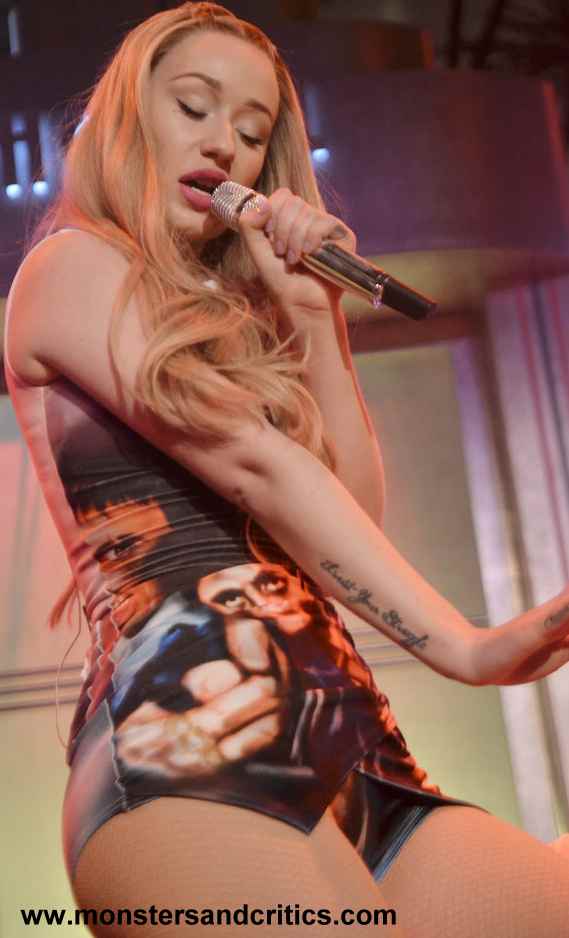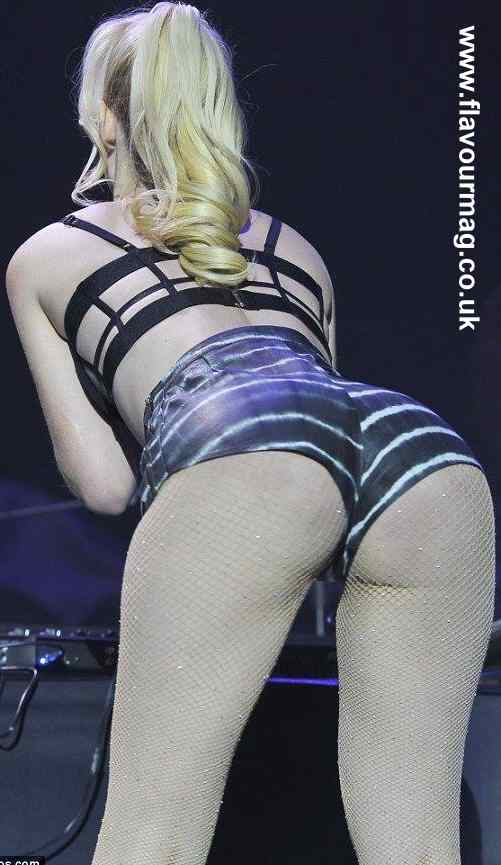|
|
iggy azalea and the reality performance
THE NEW REAL

by
TARA MORRISSEY
___________________________________________________
Tara
Morrissey is a PhD candidate at the University of Sydney. Her
doctoral thesis on "Hip-Hop and Whiteness in Post-Race
America" is currently under examination. Her research interest
lies in African American Studies and American Cultural Studies,
with a specific focus on race and gender in the negotiation
of the American 'self.?'
I’m
the first of my kind,
You ain’t seen any?
Iggy Azalea,Murda Bizness’
Hip-hop
is a site of simultaneous representation and creation, reflection
and revision. The well-worn hip hop mantra of ‘keeping
it real’ simultaneously points to retention (‘keeping,’
maintaining) and the elusive ‘real’ in which the
culture has remained invested since its inception in the 1970s.
Hip-hop realness should not, however, be confused with realism,
but rather understood as a performative gesture. Likewise, the
twenty-first century proliferation of the reality television
genre celebrates the performance of the hyper-real in a way
that deliberately complicates traditional distinctions between
fiction and reality. In his manifesto on our contemporary infatuation
with reality, David Shields argues that “realness is not
reality, something that can be defined or identified. Reality
is what is imposed on you; realness is what  you
impose back.” Australian rapper Iggy Azalea, whose positionality
as a white female in hip-hop’s problematically black male-centric
space immediately troubles her bid for hip-hop authenticity,
presents a particularly interesting case for the ways in which
twenty-first century performances of the hyper-real in both
hip-hop and reality television converge. you
impose back.” Australian rapper Iggy Azalea, whose positionality
as a white female in hip-hop’s problematically black male-centric
space immediately troubles her bid for hip-hop authenticity,
presents a particularly interesting case for the ways in which
twenty-first century performances of the hyper-real in both
hip-hop and reality television converge.
Although
the particularities of what constitutes real-ness or authenticity
in the hip-hop context have in the years since the culture’s
documented beginnings been subject to a continuous process of
revision and redefinition, the ethos of being real and representing
oneself authentically remains an important part of hip-hop’s
politics of performance. The advent of reality television, another
pop cultural form transfixed by the space between performance
and reality, has, in turn, contributed to the proliferation
of the ‘real’ as a contested cultural space. The
phenomenon designated by Geoff King as ‘the spectacle
of the real’ particular to reality television thus provides,
I argue, a contemporary framework through which to revise and
re-envision realness and performance in twenty-first century
hip-hop. Hip-hop culture’s persistent preoccupation with
the real, and what Misha Kavka describes as the distinctly queered
instantiation of the real upon which reality television is hinged,
converge in the unlikely emergence of incredibly popular (albeit
polarizing) hip-hop reality shows such as Run’s House,
Flavor of Love, Love and Hip-Hop, and T.I. and Tiny: The Family
Hustle, amongst others. The correlation between these seemingly
distinct genres may then, as Kevin Young suggests, aid in understanding
what hip-hop actually means when it invokes the real:
Is it any accident that the rise of hip-hop realness precedes
and parallels that of ‘reality television’? . .
. The very term ‘reality show’ is a paradox of the
highest order, but does describe the mix of mask, role-playing,
and personae found on these forms of television —complete
with literal and societal scripts — and in far more subtle
form in hip-hop.
Notwithstanding
Young’s insightful contemplation of the concomitant explorations
of real-ness in reality television and hip-hop, however, the
relationship remains unexplored by scholarship from either discipline.
Hip-hop, a popularly masculinized space in which female performers
must negotiate and legitimize their presence, and the disparagingly
feminized realm of trash television and, by extension, its ‘trashy’
viewers, merge in this account in a way that highlights the
necessary constructedness of the real in both genres.
Throughout
the 1990s, hip-hop realness was predicated primarily on conformity
to a certain class-based, racial, and autobiographical authenticity.
Although these factors still contribute in a superficial way
to the aesthetic of hip-hop and its ‘cool’ marketability,
contemporary hip-hop culture evidences a more self-conscious
approach to realness and its paradoxical limitations, of which
scholarship on black music has long been aware. The problem
of authenticity in pop cultural performance is an intrinsically
racialized one, whereby, as Gilbert B. Rodman expounds,
mainstream rock, folk, and country musicians have much more
liberty to use the first person to utter violently aggressive,
sexually provocative, and/or politically strident words than
do artists working in genres like dance or rap. Which means
— not coincidentally — that the artists most frequently
denied the right to use the fictional ‘I’ tend to
be women and/or people of colour.
Michael
W. Clune also gestures to the inherent paradox at work in hip-hop’s
ethos of authenticity, namely that “the ascendant performance
conceit is that there is no performance going on.” Hip-hop
authenticity is therefore always already destined for failure,
wherein “the attempt to resolve the tension between the
formal ‘you’ of the rap lyric and the ‘you’
of the audience thus has the unexpected effect of turning the
once-celebrated figure of the rapper into rap’s ritualized
object of scorn.” Authenticity becomes the open secret
of hip-hop discourse, an acknowledged implausibility but an
omnipresent factor in the hip-hop performance. Young, too, understands
this performed real as part of a black American tradition of
counterfeit — the difference between ‘truthfulness’
and ‘troofiness’ that has proven to be a worthy
tool for both the literal and the figurative survival of black
America. “Since previously conceived notions of truth
have often oppressed black people,” Young writes, “the
counterfeit is a literary tool that fictionalizes a black ‘troof.’
Such a black, vernacular-based reality proves quite different
from a white-dominated historical, factual, and authenticated
one.”
 That
Iggy Azalea is Australian renders her not only distant from
this cultural background to hip-hop’s investment in the
real, but also immediately ineligible for U.S. hip-hop’s
traditional neighbourhood-based channels of authentication,
or what Murray Forman terms the “extreme local upon which
[rappers] base their constructions of spatial imagery.”
Based in Atlanta, Georgia, signed to U.S. hip-hop label Grand
Hustle Records, and marketed within the Dirty South subgenre
of hip-hop with which the city is associated, Azalea complicates
hip-hop’s crucial investment in place of origin. Her disinclination
to identify as Australian hip-hop artist rejects essentialisms
of selfhood and self-representation and violates one of the
mainstays of hip-hop authenticity, the declaration of allegiance
to the rapper’s particular ‘hood. Indeed, in her
2013 song “Work,” the refrain of ‘no money/no
family/sixteen in the middle of Miami’ firmly establishes
the genesis of Iggy Azalea the rapper as ‘after’
her relocation to the U.S. Solidifying this erasure of Australian
influence is the fact that, unlike many other successful white
Australian rappers such as The Hilltop Hoods, Bliss n Eso, or
360, Azalea does not rap in an Australian accent. Instead, the
American twang of her delivery is most consistent with the Dirty
South tradition. That
Iggy Azalea is Australian renders her not only distant from
this cultural background to hip-hop’s investment in the
real, but also immediately ineligible for U.S. hip-hop’s
traditional neighbourhood-based channels of authentication,
or what Murray Forman terms the “extreme local upon which
[rappers] base their constructions of spatial imagery.”
Based in Atlanta, Georgia, signed to U.S. hip-hop label Grand
Hustle Records, and marketed within the Dirty South subgenre
of hip-hop with which the city is associated, Azalea complicates
hip-hop’s crucial investment in place of origin. Her disinclination
to identify as Australian hip-hop artist rejects essentialisms
of selfhood and self-representation and violates one of the
mainstays of hip-hop authenticity, the declaration of allegiance
to the rapper’s particular ‘hood. Indeed, in her
2013 song “Work,” the refrain of ‘no money/no
family/sixteen in the middle of Miami’ firmly establishes
the genesis of Iggy Azalea the rapper as ‘after’
her relocation to the U.S. Solidifying this erasure of Australian
influence is the fact that, unlike many other successful white
Australian rappers such as The Hilltop Hoods, Bliss n Eso, or
360, Azalea does not rap in an Australian accent. Instead, the
American twang of her delivery is most consistent with the Dirty
South tradition.
Australian
hip-hop, especially in its most commercially successful Anglo-Australian
incarnation, focuses its process of authentication on an imaginative
space in which hip-hop, as freestanding entity, is organically
and intuitively more real to the hip-hopper than mainstream
Australian cultures. Ian Maxwell’s important work on Australian
hip-hop practices presents a thorough and theoretically considered
analysis of the phenomenon of, in particular, white Australian
men in the outer Western suburbs of Sydney and their engagement
with the imaginatively evoked Hip-Hop Nation. Given the antipodean
absurdity with which the very existence of a flourishing hip-hop
community amongst white Australians might be interpreted in
the U.S. context, Maxwell’s study focuses on the steadfastness
and conviction of the subjects claiming allegiance to a Hip-Hop
Nation that is believed to supersede ethnicity, gender, socioeconomic
status and, indeed, nationality. “In no way,” he
argues, “might these processes [of authentication] be
seen as being (merely) culturally promiscuous, as celebrating
a postmodern valorization of the pastiche, a privileging of
the playfully eclectic for its own sake. On the contrary, the
use of the term ‘community’ precisely bespeaks a
concern with ‘the authentic,’ with tradition and
the fixing of values.” Maxwell points to this imagined
Hip-Hop Nation as crucial to the Anglo-Australian hip-hopper’s
perception of authenticity. In the absence of viable claims
to ethnic or experiential kinship in the “geographically
discontiguous, isolated, and multicultural” context of
Australian hip-hop, legitimacy of Australian hip-hop “largely turns
on the possibility of ascribing to local performance an authenticity
that had to be articulated to a discontinuous, geographically
remote narrative of origin.”
hip-hop, legitimacy of Australian hip-hop “largely turns
on the possibility of ascribing to local performance an authenticity
that had to be articulated to a discontinuous, geographically
remote narrative of origin.”
The
Hip-Hop Nation and its ability to mobilize those who hear its
call resonates with a diverse spectrum of Australian society
— the recent work of Australian-born rapper, activist
and academic Sujatha Fernandes, for example, testifies to hip-hop’s
multi-ethnic appeal as well as its international mobilization.
Further, Maxwell’s description of the self-authenticating
process of hip-hoppers in the Australian context resonates with
Azalea’s own account of her connection to U.S. hip-hop
culture. In the words of Maxwell:
an individual in Sydney, Australia, in 1992, could, they claimed,
get Hip-Hop Culture from a television video clip, and . . .
what they understood as being the essence of that culture is
so pure, so transcendent, that the being-ness of an African
American was seen, in effect, as an expression of that transcendent
ground, rather than the other way around.
Azalea
in turn describes her induction into hip-hop through a narrative
of self-alienation and online access to performance. “Sometimes
I would not go to school at all. I would be at home writing
raps, trying to be a rap star. I thought it was so cool. I would
see all the rap videos and watch them on YouTube,” and,
later, “Australia doesn’t have radio stations that
play hip-hop. You had to go on Google or look on Billboard to
see what was going on in America. I would go on MySpace to see
what other kids were listening to. I was just manning the internet
trying to find stuff that was cool.” The instinctive gravitation
towards Maxwell’s Hip-Hop Nation that Azalea describes
echoes Fernandes’s own narrative of hip-hop discovery
while viewing Grandmaster Flash and the Furious Five’s
“The Message” music video: “There was something
fitting about my close identification with a fabricated product
that revealed so many truths.” The Hip-Hop nation forms
part of an important fable of hip-hop authenticity, a broader
marketing of the real that is mobilized not to enact stringent
guidelines as to who or what is real, but rather to incorporate
diverse hip-hoppers into a rudimentary shared mythology of sameness.
In
an interview with Australian hip-hop journalist Boss Lady, Azalea
can be seen to navigate simultaneously the twin imperatives
of Australian hip-hop and broader hip-hop authenticity. In an
attempt to justify her involvement in hip-hop and downplay the
incongruity of a white Australian woman in a culture dominated
by iconography of black masculinity, Azalea insists that although
hip-hop is, in her understanding, a black cultural product,
it has become, over time, “more than what it was before
and more than the main elements of it, you can have places for
other people to fit in.” Azalea’s attempt to account
for the evolution of hip-hop’s racial politics and thus
validate her claim to legitimacy — her right to hip-hop
— reveals two significant assumptions about race and its
relationship to hip-hop. First, the aforementioned problematic
myth-of-origin that hip-hop is black culture and second, that
her ability to speak both for and from hip-hop is determined
by a social performance of deference that underpins her responses
to the race question throughout this and other interviews. Indeed,
Azalea’s evident hesitation and the circumlocution of
her response typify awareness, rather than transcendence, of
her white positionality. Indeed, although Azalea suggests that
the importance of race in hip-hop’s process of authentication
has lessened as hip-hop culture has been diffused around the
world, she is, at the same time, eager to align herself with
blackness. In particular, Azalea’s body becomes the signifier
through which she is implicitly marketed as a hip-hop woman.
In
an interview with hip-hop magazine Complex, Azalea
offers the first of her embodied connections to blackness, and
one that is constructed as distinctly Australian. In a section
of the interview titled Growing Up in Australia, Azalea recounts
that “lots of the small towns in Australia have Aboriginal
names,” and that her town, Mullumbimby, is one of them.
She goes on to make more direct her association with Indigenous
Australia, asserting rather problematically that “if your
family’s lived in Australia for a long time, everyone
has a little bit of [indigenous blood]. I know my family does
because we have an eye condition that only Aborigine people
have.” The seemingly casual reference to possible indigenous
ancestry aims to do two important things. First, to indicate
blackness, and thus hip-hop authenticity, on a level distinct
from yet adjacent to U.S. blackness, and second, to lay claim
to an essential Australianness that irrevocably undermines accusations
that Azalea has rejected her Australian identity or failed to
authentically embody it, perhaps most notably through her accent.
She is also, importantly, distanced from whiteness as understood
in the U.S. context by association with an exoticized image
of Australia and connection to non-white indigenousness.
The
second, and more apparent means through which Azalea physically
aligns herself with blackness is through the shape of her body.
Boss Lady cites an apparent rumour as to Azalea’s  modeling
career, asking her, “I read that you were rejected as
a model at one point because you were too thick, is that . .
.?” Azalea responds that “it’s weird, though,
because I so don’t feel like I’m thick, I really
feel like people think I’m, like, bigger than what I am!
I’m not that big!” Focus on Azalea’s body
shape typifies not only the way in which popular culture emphasizes
female sexuality and sex appeal in its evaluation of female
performance, but also the particular lens through which hip-hop
scrutinizes and authenticates its female practitioners. Boss
Lady’s nod to the size of Azalea’s posterior is,
indeed, an authenticating gesture readily interpretable by hip-hop
audiences long-accustomed to hip-hop’s fixation with ‘bootylicious’
imagery. Like Nicki Minaj, and rappers such as Lil’ Kim
and Trina before her, Azalea’s videos are dominated by
close-ups of her buttocks and showcase a variety of suggestive
dances, techniques that unequivocally situate the female hip-hop
form within the stripper-sex kitten-seductress paradigm already
prevalent in male hip-hop videos. Reference to Azalea’s
thickness thus helps to sanction her participation in hip-hop
alongside her black female contemporaries by endowing her with
a dormant, interior blackness. Hip-hop’s interest in the
proverbial big butt, however, also complicates simplistic understandings
of realness in that the surgical enhancement of the historically
sexualized exotic female buttocks has become an increasingly
popularized and culturally recognized phenomenon. Physical blackness,
specifically black femaleness consistent with hip-hop’s
particular brand of realness can, in this sense, be manufactured,
as Imani Perry argues in her critique of hip-hop videos and
their unrealistic portrayals of black femininity. “Colour
is aligned with class and women are ‘created’ (i.e.
through weaves, pale makeup, and camera filters) and valued
by how many fantasy elements have been pieced together in their
bodies.” Azalea’s self-promotion as a white woman
with the desirable curves of hip-hop’s fantasy black woman
is thus incredibly loaded. modeling
career, asking her, “I read that you were rejected as
a model at one point because you were too thick, is that . .
.?” Azalea responds that “it’s weird, though,
because I so don’t feel like I’m thick, I really
feel like people think I’m, like, bigger than what I am!
I’m not that big!” Focus on Azalea’s body
shape typifies not only the way in which popular culture emphasizes
female sexuality and sex appeal in its evaluation of female
performance, but also the particular lens through which hip-hop
scrutinizes and authenticates its female practitioners. Boss
Lady’s nod to the size of Azalea’s posterior is,
indeed, an authenticating gesture readily interpretable by hip-hop
audiences long-accustomed to hip-hop’s fixation with ‘bootylicious’
imagery. Like Nicki Minaj, and rappers such as Lil’ Kim
and Trina before her, Azalea’s videos are dominated by
close-ups of her buttocks and showcase a variety of suggestive
dances, techniques that unequivocally situate the female hip-hop
form within the stripper-sex kitten-seductress paradigm already
prevalent in male hip-hop videos. Reference to Azalea’s
thickness thus helps to sanction her participation in hip-hop
alongside her black female contemporaries by endowing her with
a dormant, interior blackness. Hip-hop’s interest in the
proverbial big butt, however, also complicates simplistic understandings
of realness in that the surgical enhancement of the historically
sexualized exotic female buttocks has become an increasingly
popularized and culturally recognized phenomenon. Physical blackness,
specifically black femaleness consistent with hip-hop’s
particular brand of realness can, in this sense, be manufactured,
as Imani Perry argues in her critique of hip-hop videos and
their unrealistic portrayals of black femininity. “Colour
is aligned with class and women are ‘created’ (i.e.
through weaves, pale makeup, and camera filters) and valued
by how many fantasy elements have been pieced together in their
bodies.” Azalea’s self-promotion as a white woman
with the desirable curves of hip-hop’s fantasy black woman
is thus incredibly loaded.
Reality
television, unlike hip-hop, is a genre that is explicitly feminized
both in its promotion and in critical and popular evaluations
of its worth – or lack thereof. Kavka interprets the feminization
of reality television as part of a broader cultural imbrication
of televisual pleasure with the domestic sphere, explaining
that “during the nineteenth century the consolidation
of domesticity and consumption as ideological patterns occurred
specifically in reflexive relation to femininity, with the result
that the twentieth-century apparatus of television easily became
associated with, and devalued as, feminine practice.”
That a particular realm of televisual pleasure is relegated
to the demeaning category of trash “suggests that it perverts
the host medium by planting ‘trash’ as a literal
parasite on TV.” “The criticism,” Kavka continues,
“that reality TV is not in fact ‘real’ because
the shows are heavily manipulated (read: nobody actually lives
like that) is also dependent on the construct of a dumbed-down
viewership that conflates what plays out on one side of the
screen — framed as spectacle — with what happens
on the other — grounded in the experiential world.”
The scorn with which aficionados of underground or conscious
hip-hop interpret audiences of commercial hip-hop is similarly
grounded in a logic of intellectual inferiority at best, and
gullibility or naivety at worst. What dismissive readings of
both reality — trash — television and mainstream
hip-hop’s discourse of the real misinterpret, however,
is that the un-realness of the real is precisely the point,
or, in Kavka’s words, “the appeal of reality TV
lies precisely in its performance of reality in a way that matters.”
Indeed,
if the premise of reality television is its distinction from
fiction-based television, it is only superficially so. Ardent
fans of reality television understand and appreciate the manipulation
and editorial intervention at work in the production of televised
reality in the same way that soap audiences fully expect deceased
characters to resurrect, passionate affairs to perpetually begin
and end, and child characters to rapidly and inexplicably mature.
The same suspension of disbelief at work in traditional narrative
television remains a constant; what distinguishes the reality
genre is less its plot (scripted drama) than its setting (the
real world). As Shields elaborates, “we have a thirst
for reality (other people’s reality, edited) even as we
suffer a surfeit of reality (our own — boring/painful).”
The common line of criticism with which reality television is
derided, nonetheless, is framed as a kind of ‘outing’
of the manufactured or manipulated aspects of a given show —a
n exposÈ of the ostensible deception at play in the use
of the reality tagline. In short, the notion that reality or
the real can be performed, or can coexist with performance,
proves to be the sticking point for reality television’s
critical acceptance. Kavka’s interpretation of the reality
TV performance as “less a matter of “acting”
in the sense of simulation than of ‘acting out,’
a performance of the self which creates feeling” presents
a more workable understanding of the performance of authenticity
that correlates, in turn, with Maxwell’s description of
the freestyle rap practices of Australian male rappers. In both
scenarios, an external accusation of inauthenticity —
or, if not in so many terms, performance as the antithesis of
realness — is seen to destabilize the medium and, in so
doing, expose its fraudulence and concurrent ineffectiveness.
In Kavka, the scripted dimension and/or mediation of reality
television “is all television and no reality,” and
in Maxwell, the illusion of spontaneity in freestyle or battle
situations is its own undoing: ‘“But,” another
informant warns me, ‘you realize that none of them are
really improvising . . .’”
Surgical
cosmetic enhancement and the increasingly commonplace presence
of the plastic in the realm of the natural (much like the previously
discussed enhancement of assets in hip-hop) are coterminous
in reality television such as the Real Housewives franchise
with the fabrication and exaggeration of wealth and assets,
as well as the framework of gossip and back-stabbing from which
much of the dramatic appeal of the series is derived. The real
on offer, the audience comes to understand, is a constructed
real, mediated not only by the editorial tools of televisual
production but also, increasingly, by the housewives themselves.
Veneers become the open secret of the series that facilitates
our relation to and understanding of the show’s participants
and, concurrently, provide a space for intimacy between the
audience and the participant in the form of the promise of divulgement
or confession in the one-on-one cutaway sequences in which the
participant reveals her real response to the show’s dramatic
events. The openness of the franchise and its participants towards
surgical enhancement offers an unapologetically mediated interpretation
of the real, the premise being along the lines of, ‘I’m
not real but I’m real about it; I have nothing to hide.’
Within this framework the real becomes synonymous with transparency
and, as such, is negotiated not between the show’s participants
themselves but between the audience and each individual participant.
Real, in the culture of the series as a collective, is thus
dependent upon this reciprocal intimacy. What can it mean for
the frankness of artifice — real-ness — to replace
the truthfulness with which authenticity is traditionally configured?
In
her music video “Murda Bizness ft. T.I.,” Azalea
enacts a performance that interpolates the iconography of hip-hop’s
Dirty South with the markers of whiteness made luminous by the
explosion of reality television in popular culture. In effect,
Azalea incepts the reality television real (plastic whiteness)
within the real of ghettocentric hip-hop authenticity and, in
so doing, offers a conscious performance of realness that both
acknowledges her superficial incongruity in the masculinized
black space of U.S. hip-hop and suggests that performance of
a hyper-real authenticity of self is germane to hip-hop realness.
The video lampoons child beauty pageantry, an American subculture
that at the time of the video’s release was enjoying mainstream
attention as a result of reality television’s gonzo-style
explorations of its participants.
Pageantry,
itself obviously a performative practice, is rendered ludicrously
so in its pre-adolescent form: the aesthetic of the high-glitz
pageant, in particular, demands that the participant be appropriately
presented in full make-up, fake tan, hairpiece, false eyelashes,
acrylic nails, and the flipper, a removable veneer that gives
the appearance of adult teeth. The glitz pageant stands in opposition
to the lesser natural pageant, a binary that makes perfectly
clear the necessary, indeed compulsory, un-naturalness or constructed-ness
of the former. Lyrics such as,
These
other bitches think they’ hot?/Not really./She a broke
ho’/That’s how you know she’s not with me,’
‘I’m God’s honest truth,/They decide to lie/They
just divide they’ legs/I divide the pie’ and ‘Shit,
I’m IMAX big/You’re poster size’
mark
but a few examples of the rivalry by which “Murda Bizness”
is characterized. Teamed with images of glitz pageant children
that recall the dramatic rivalries enacted in Toddlers and Tiaras,
the performative nature of Azalea’s boast is exposed at
the same time as the very real effects of rivalry are nurtured,
developed, and deemed necessary to the successful performance
of femininity. The common thread of rivalry throughout hip-hop
and reality TV is similarly noted by Young in his argument that
the genres share particular interpretations of realness:
Nor is it a coincidence that participants in both rap and reality
TV — even when it is seemingly for love — refer
to their respective genres as the Game? If for rap it’s
called that because of the business (as well as its symbolic
relationship to the ‘drug game’ or the ‘fight
game’), both genres are highly aware of the parameters
(which are few) implied by the idea of a game, and refer to
realness and gaming in nearly the same breath, without irony
(which is otherwise rampant).
Rapper
T.I., whose own work – in particular his family-oriented
reality show T.I. and Tiny: The Family Hustle – has chronicled
his evolution from drug dealer to platinum-selling rapper and
self-professed family man, also appears in the video with his
stepdaughter Zonnique Pullins. The duo’s over-performance
of a pageant father and his diva-like daughter is of particular
interest in that it serves to distance hip-hop (via T.I.) from
the overt performance of pageantry at the same time as it troubles
the credibility of T.I.’s gangsta rap persona throughout
the remainder of the video. Indeed, the video presents a palimpsest
of real performance: the official performances on the pageant
stage; the cutaway interviews characteristic of reality television
in which participants play up their personalities in hopes of
making an impact on the show’s audience; the performance
of Azalea, T.I., Zonnique, and the rest of the cast in the pageant
roles; and, finally, the hip-hop performance by which the entire
work is framed.
Hip-hop’s
preoccupation with the real is compelling precisely because
of its instability, its constant recalibration and, importantly,
its awareness of the distinction between (per Young) the ‘truth’
and the ‘troof.’ Contemporary fascination with what
Shields terms “the extraordinary drama of lied-about ordinary
life,” crystallized in the increasing proliferation of
reality television, brings the long-discussed real of hip-hop
into a newly valorized position of prominence in popular culture.
Kavka’s assertion that discussion of the real is ultimately
invested in “value judgments that operate in binary relations”
whereby “inevitably, what is real is good, - a judgment
that works colloquially in its obverse, what is good is real
— while what is mediated is bad, and bad for you ‘
effectively summarizes the devaluation of reality television’s
performed real. Within its broader analysis of reality television
as a feminized and concurrently disparaged cultural space, however,
it may also prove useful in shedding light on the ways in which
realness is performed by hip-hop’s women. If, as Mark
Anthony Neal suggests, “ultimately all concerns about
authenticity in hip-hop begin and end with the fear of the proverbial
white rapper,” the recent emergence of the female white
rapper in mainstream U.S. hip-hop surely marks a crucial turning
point in hip-hop’s ongoing mediation of the real. What
remains to be seen, of course, is whether Azalea’s particular
mobilization of contemporary experimentation with realness in
its various pop cultural manifestations affords her longevity
in a hip-hop scene still skeptical of both white and, arguably,
female performance.
|
|
|